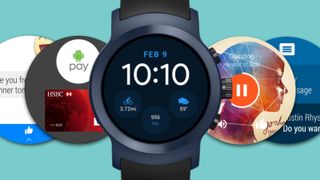Things are looking up for the wearables market
Analysts are expecting a return to growth

After a period of what must have felt like hopeless and endless decline for smartwatch manufacturers, analysts are predicting that we could see the wearables market return to growth.
In 2016, we saw repeated reports that the smartwatch market was declining, with disappointing sales and increasingly uninterested customers. The declining interest wasn’t helped by the delayed release of Android Wear 2.0 which made almost every device other than the Apple Watch feel like it was stuck in stasis.
Now that Android Wear 2.0 has been launched, bringing with it a new generation of smarter smartwatches, the International Data Corporation (IDC) is predicting we’ll see worldwide wearable device shipments grow from 102.4 million units in 2016 to 237.5 million by 2021.
This would be a compound annual growth rate of 18.3 % and IDC say it’ll be possible thanks to “new vendors, emerging form factors, and an expanded number of retail outlets.”
Tracking growth
IDC's senior research analyst, Jitesh Ubrani, predicts that we’ll see companies increasingly focus on fashionable design both to distinguish themselves from one another and draw in a wider range of consumers, particularly those who don’t prioritize form-factor over the latest technology.
“Tech companies will be forced to step up their game and offer a wider selection of sizes, materials, and designs in order to appeal to a broader audience. We also expect more tech vendors to partner with fashion brands for their creativity, and equally important, their distribution network.”
Not only that, they predict that we’ll also see watches diversify and appeal to greater numbers by making them more specific in their functions as well as their forms.
Get daily insight, inspiration and deals in your inbox
Get the hottest deals available in your inbox plus news, reviews, opinion, analysis and more from the TechRadar team.
Manufacturers will “hyper-segment into specific niches, including connected kids' watches, athletic watches, luxury and fashion watches, and lifestyle watches that better address different segment needs, whether they be communication, health and fitness, or as smart luxury and fashion timepieces."
Rather than creating one watch that tries to do everything, they say that we'll see different watches offer different features to do the job the consumer expects them to.
Outside of smartwatches, IDC also predicts growth in earworn devices and smart clothing which will increasingly integrate fitness tracking and coaching capabilities.
Though growth is predicted for these products, IDC says it’s likely to be more “modest” as their “primary features of health and fitness tracking [...] overlap with the more popular wrist worn devices” which are already familiar to consumers.
Their increased presence on the market is something we've noticed ourselves, with notable examples including Google and Levi’s smart clothing collection Project Jacquard and Sony’s experimental Xperia Ear device that was shown at this year’s MWC in Barcelona.
Emma Boyle is TechRadar’s ex-Gaming Editor, and is now a content developer and freelance journalist. She has written for magazines and websites including T3, Stuff and The Independent. Emma currently works as a Content Developer in Edinburgh.
Most Popular

